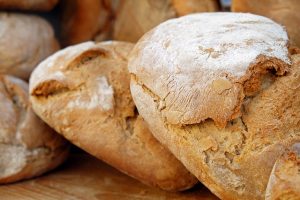This page contains affiliate links. We may earn money or products from the companies mentioned in this post through our independently chosen links, which earn us a commission. Learn More
 The short answer is yes, dogs can eat bread, either plain white or wheat bread, and it won’t cause any allergies or stomach illness. Be advised that time to time feeding your dog bread isn’t an issue, but with that said, we must not ignore the fact that dogs need a complete diet.
The short answer is yes, dogs can eat bread, either plain white or wheat bread, and it won’t cause any allergies or stomach illness. Be advised that time to time feeding your dog bread isn’t an issue, but with that said, we must not ignore the fact that dogs need a complete diet.
I know that when I got my first dog, I had no idea which human foods she could safely eat, which is why I’ve put this article together for you, so you can learn from what I’ve discovered.
Contents & Quick Navigation
What’s Safe, and What’s Not?
You see, certain foods are toxic for dogs, and among those foods are grapes, raisins, onions, garlic, macadamia nuts, and artificial sweeteners. Now, if you were wondering, what about bread? Is bread bad for dogs?
Can dogs eat bread?
Dogs can eat bread…well, sometimes.
It really does depend on its type. So you’ll want to make sure to keep your cinnamon-raisin bread, garlic knots, and onion bagels out of your dog’s reach. If your dog accidentally ingests bread with onions or onion powder, it can lead to anemia, but according to this video from Veterinary Secrets, once you take the onions away, your dog should heal pretty quickly.
When it comes to grapes and raisins, however, there is no known treatment, so under absolutely no circumstances should your dog have easy access to these!
Yeast and Your Dog: They Don’t Get Along
While plain white bread is usually fine for many dogs, if you’re in the habit of making fresh pizza or your own bread, it’s easy to forget and just leave kneaded dough on the counter to rise. But even if you have to set a reminder for yourself on your phone, make sure you always keep raw dough out of your dog’s reach, as it is extremely harmful to our furry friends!
The last thing you need is your dog jumping or climbing up onto the counter and chowing down, because, according to ASPCA, if a dog consumes raw dough, the yeast will cause the dough to rise within the dog’s stomach. The rising of the yeast would cause the abdomen to stretch.
If you’ve ever been bloated, you know just how painful that is! As yeast ferments and prompts the dough to rise, ethanol or alcohol is produced. This same alcohol can actually give your dog ethanol toxicosis, which can trigger a cardiac arrest and prove fatal for dogs!
Just in case, if you ever have any doubts that your dog has ingested raw dough, keep an eye out for:
- a bloated abdomen
- vomiting
- loss of coordination
- loss of bladder control
- any behavior changes or depression.
All of these are symptoms of ethanol toxicosis, and they begin to present from half an hour to two hours after the consumption of raw dough. If you see any of these symptoms at all, don’t hesitate and head to the vet! If untreated, your dog’s health will rapidly deteriorate, even to the point of death.
What You Need to Know
First, make sure that your dog doesn’t have a wheat allergy. If it turns out that your dog is allergic to wheat and you’d still like to feed her some bread, opt for bread made with rice or rye flour. Homemade bread would also be ideal since you can easily control the ingredients.
Second, even if your dog does go absolutely gaga for bread, make sure not to feed her too much, as bread is high in calories and you don’t want your canine companion to become overweight. For this same reason, you should also avoid bread that is high in sugar.
The best thing you can do in this case is to reserve it as a treat for special occasions and stick to small pieces that can easily be digested. And, of course, make sure your dog gets plenty of exercises!
Anything Else?
So, let’s recap. Can dogs eat bread?
Sure, if you feed your dog small portions of:
- Bread made from rice flour
- Rye Bread
- White or Whole Wheat (if your dog isn’t allergic)
And you should avoid these altogether:
- Raw dough
- Cinnamon-raisin bread or bagels
- Onion bread or bagels
- Garlic bread and knots
That is pretty much all you need to know! Of course, our dogs can’t communicate the way we do, but with a little bit of vigilance and care from you, your dog will always be happy and healthy.
Just keep a light hand with the bread, and maybe reach for some yummy chews or a bit of peanut butter the next time your furry friend is looking for a snack!
Do you have any other concerns about what your dog should be eating? Let me know in the comments!

3 replies on “Can Dogs Eat Bread? (And When Yeast is Super Dangerous)”
Thank you for sharing! I was worried because I’m babysitting my mom’s long haired miniature chihuahua who was nibbling on some Udis bread toast with some Earth Balance spread and I was worried. Helpful!
My pleasure Michelle 🙂
thanks so much! i have saw some posting “no yeast bared for dogs!” but i douted baked bread has no live yeast. then how yeast works in dogs stomach? like…
sigh isnt is silly right?
the important.thing is raw dough! not a baked bread!